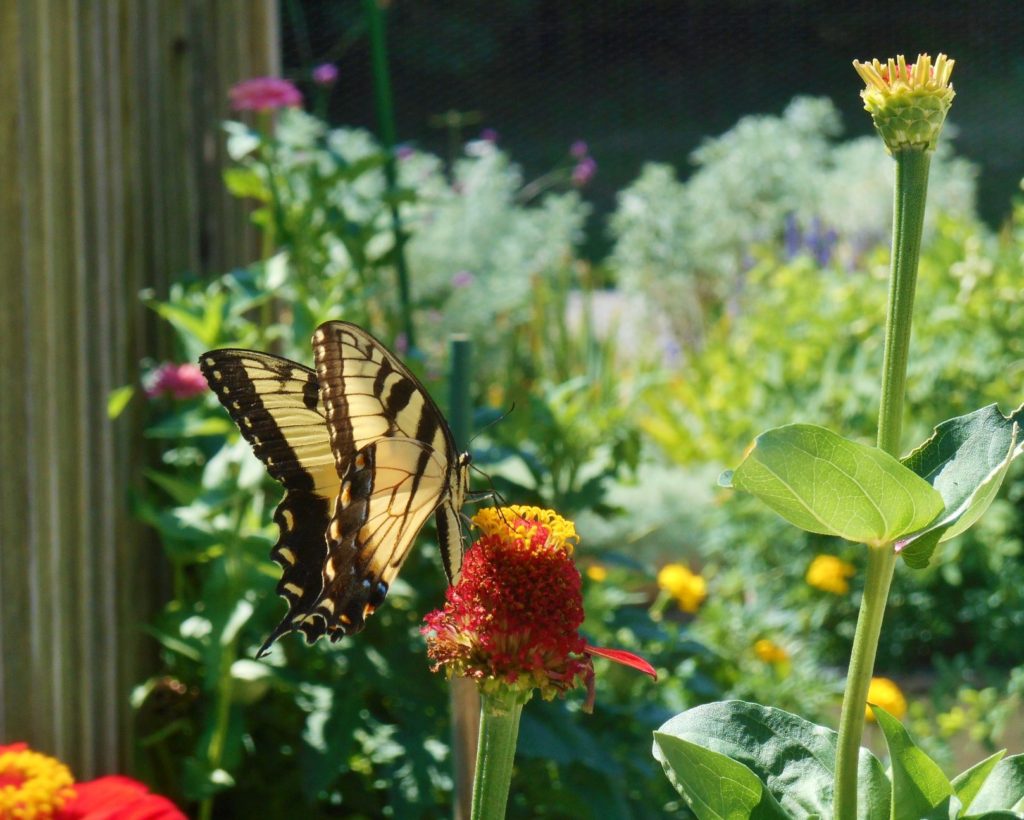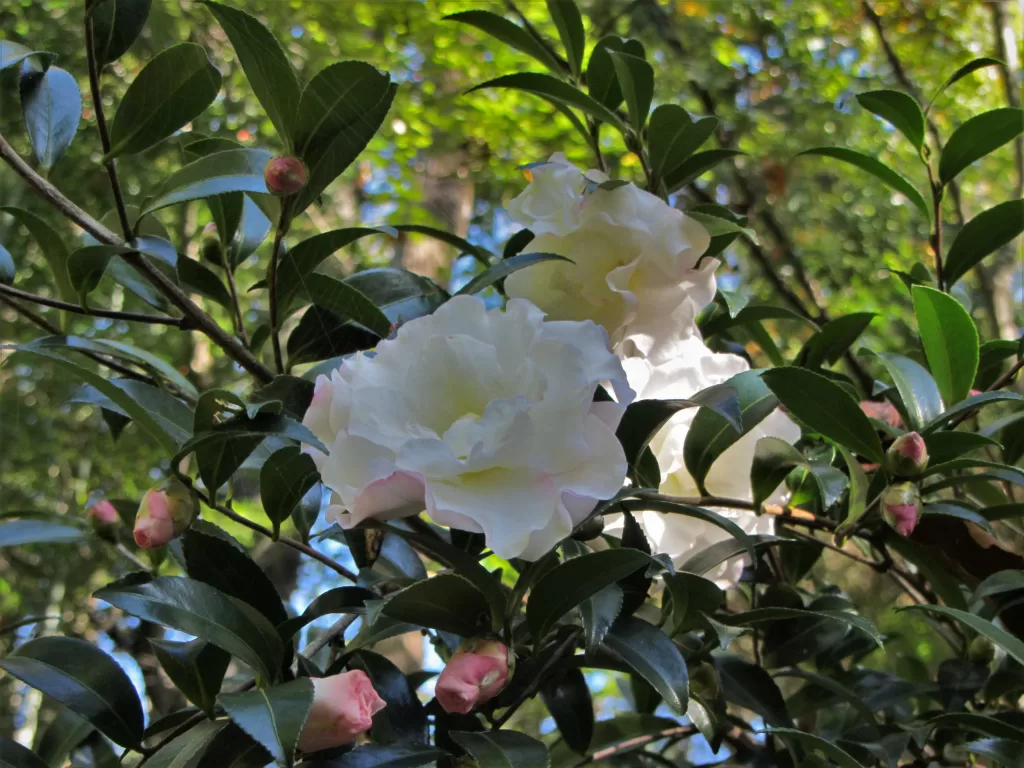How to Cultivate a Fairy Garden
“And therefore, as a stranger give it welcome. There are more things in Heaven and Earth, Horatio, than are dreamt of in our philosophy.”
William Shakespeare, from Hamlet, First Folio
Perhaps you have already made a fairy garden. It is an endearing activity for parents and grandparents to enjoy with the children in their lives. Full of whimsy and fun, we enter the world of ‘make-believe’ once again and see the world from a different perspective. Everything is miniaturized and made beautiful to invite the presence of fairies. Fairies like Tinkerbell, tiny, winged beings who flutter about like hummingbirds, or butterflies. But are they real?

The fairy garden created by the ARC group at the Williamsburg Botanical Garden and Freedom Park Arboretum. 2021
“Do you believe in fairies?” Tinkerbell asks Peter, in James Matthew Barrie’s Peter Pan. When Peter answers, ‘No,’ she pretends to die. Peter must declare his sincere belief in fairies to revive this cunning creature who has befriended him. And while this makes for classic children’s fiction, it echoes a common experience of interaction between unsuspecting people and ‘the other folk.’
Who are ‘the other folk’? That is such an interesting question, and may have more than a few satisfying answers. There is a rich folk tradition in many lands about these beings who live in a separate but parallel world to ours, the Otherworld, and choose to make themselves visible, and active in our own human world from time to time. In addition to familiar fairy lore from the British Isles, there are similar traditions in many other lands including Hawaii, Australia, Japan, Africa, Europe, and North America. Awareness of fairies seems to be worldwide.
Without diving too deeply into either quantum physics or Hermetic philosophy, we already understand that there are ‘real’ things that we cannot see, hear, or feel because they are outside of the range our physical senses can currently perceive. We see only a small range of the total spectrum of light. We hear only a small range of the spectrum of sound.
Light and sound both travel as waves, and the frequency of those waves may not fall into the range our senses perceive. We have technology that can detect a wider frequency of light and sound. When tools are tuned to the proper frequencies, we can know these higher and lower frequencies with our radios, cameras, radar, and other equipment.
Some things may be too small for us to feel on our skin or too small to see. But a microscope or hand lens proves their existence. Viruses and bacteria may be too small to see while still having a profound effect on our body. Creatures like chiggers may bite us without our sensing their presence before they attack.
When considering whether fairies, also known as nature spirits and elementals, exist, we are wise to approach the subject with full awareness of the limitations of our senses. We also acknowledge the limitations of our knowledge of the natural world. Yet wisdom traditions from antiquity teach us that the elemental kingdom of nature spirits is as real and as important to life on Earth as are the mineral, plant, and animal kingdoms.
All matter and energy vibrate at their own frequency. The intelligent beings of the elemental kingdom may simply be vibrating at frequencies beyond what our human senses normally perceive. This allows their involvement in the process of plant growth, in which energy from the sun and the Earth combine into the solid matter of leaves, stems, roots, flowers, and fruit. They ensure that newly created plant cells conform to the pattern, or archetype, of each individual species.
It is possible that some nature spirits inhabit a parallel dimension which occupies much the same space as our own, but at a different frequency. The different dimensions touch in certain ‘thin places’ or liminal spaces where contact is possible. Liminal spaces are ‘in-between’ times or places where things are not entirely one or the other. Places like caves, beaches, and times like dawn and dusk.
Folklore informs us that the nature spirits have existed on Earth for eons longer than has humankind, and that they have been continually retreating from the human world in response to our culture. At first contact with expanding human settlements, they withdrew to ever more remote areas.
The Irish tell of the Tuatha De Danaan, the children of Anu, who once ruled Ireland in the distant past. Some members of this tribe were considered gods and goddesses, but eventually withdrew into burial mounds, fairy hills, caverns, and a dimension known as ‘the Otherworld.’ Towards the end of J.R.R Tolkien’s final book of his The Lord of the Rings trilogy, The Return of the King, we see the elven races withdrawing further away from the human world as they set sail across the sea to their own elven lands.

Leptinella pusilla, purple brass buttons with Sedum
‘The Other Folk,’ also known as the sidhe (the shee), are said to have perceptual abilities far beyond our own, are both clever and wise, and can manipulate the wavelengths that make up the natural world in ways we currently don’t understand. Sometimes they choose to make themselves visible to interact with humans for various purposes, often as tricksters, but also as helpers. Some people who claim to see these beings see them as moving energetic light and color rather than seeing them with solid bodies. The sidhe are said to shape shift, appearing to grow larger or smaller and taking on different forms as needed.

Salvia rosmarinus, Rosemary
There is a relationship between elementals and the elements that make up our shared Earth. They are the guardians and caretakers of all plant life, but also of features like springs, lakes, rivers, mountains, caverns, and other elements of the natural world. The Greeks taught that sylphs live in the air, salamanders exist within fire, undines live in and around water, and that gnomes care for the stone and soil of the Earth. These energetic manifestations of the elements work to balance the forces of our planet, support life in all its forms, and cleanse and renew the natural world.
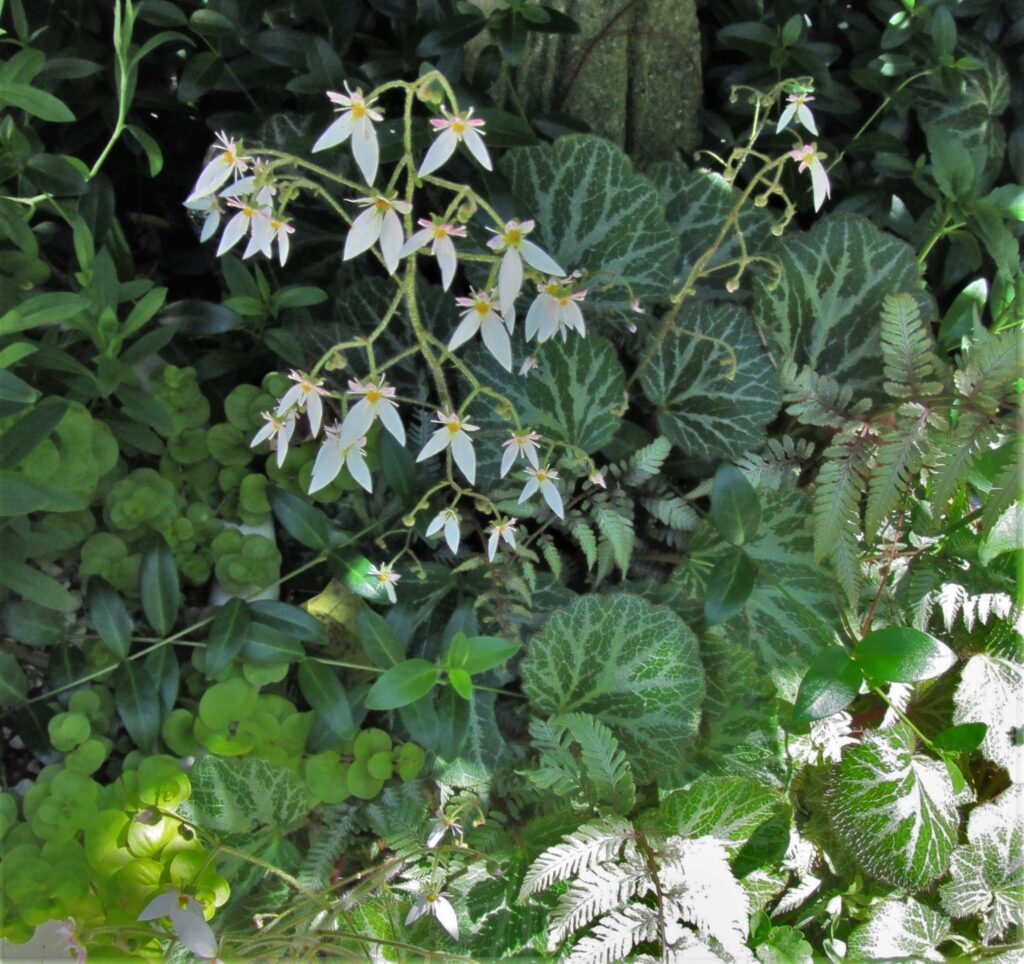
Saxifraga stolinifera, strawberry Begonia in bloom, grows with Japanese painted fern, Dianthus, Lysimachia and Vinca.
A wide variety of other energetic beings work with specific trees, herbs, flowers, ferns, vines and with fungi. While some humans report that they have developed the ability to see and hear these beings, and can relay their messages to us, most of us can’t perceive them directly. The ancients were perhaps more aware of other non-human intelligent beings and sometimes worked in partnership with them.
As modern humans have lost close ties with the natural world, moving to cities and developing their scientific knowledge and technological expertise, we have also lost our connections with the ‘mythological wisdom’ of our ancestors who saw the natural world as personified in an extended family of gods and goddesses, demigods, Fae, fairies, elves, fauns, gnomes, devas, dryads, and other beings.
Certain groups of traditional indigenous people across the planet today are aware of, and consciously work with, these non-human intelligences. Most people in ancient times worked closely with nature to raise their food and had much less technology to distract them. Modern people following a similar lifestyle, close to nature, may be able to form a partnership more easily with fairies and other elementals.
In 1690-92, The Reverend Robert Kirk, a minister in Scotland, wrote The Secret Commonwealth of Elves, Fauns, and Fairies based upon his own experiences and the experiences of members of his congregation. He claimed to have made contact and established good relationships with the Fae living in his area of Scotland, and he believed that people in general should know about these ‘other folk.’ Rev. Kirk was interested in researching the ‘second sight,’ or extrasensory perception that many people had in his community, and how their enhanced perception allowed them to see and interact with the fairies.
He died, or disappeared, under very mysterious circumstances on a ‘fairy mound’ near his church in 1692. He was in his mid-50’s and in good health at the time. Some believed that the fairies took him to live among them, and his fate has remained a mystery. His book wasn’t published publicly until 1815, yet it is still well respected as an important historical work about the Scots’ beliefs in fairies and the second sight.
As Irish, British, Welsh, and Scots colonists moved westwards into the Appalachian Mountains, their beliefs in ‘the Good People’ and ‘the Other Folk’ blended with the indigenous beliefs of “Little People” called “Yunwi Tsunsdi” in Cherokee, and the “Nunnehi,” considered immortal animistic spirits of the Appalachians. The Osage people, also living in the Appalachians before settlers moved westwards, recognized the spirits of the land which they called “mi-lo’n-shka.” There was already a shared understanding of elementals between the largely Scots settlers coming into the Appalachian and Blue Ridge Mountains west of the colonies and the native peoples living there. Interestingly, these mountains were once joined with the mountain ranges found in the British Isles before the supercontinent of Rodinia broke up and the lands drifted apart over a billion years ago.
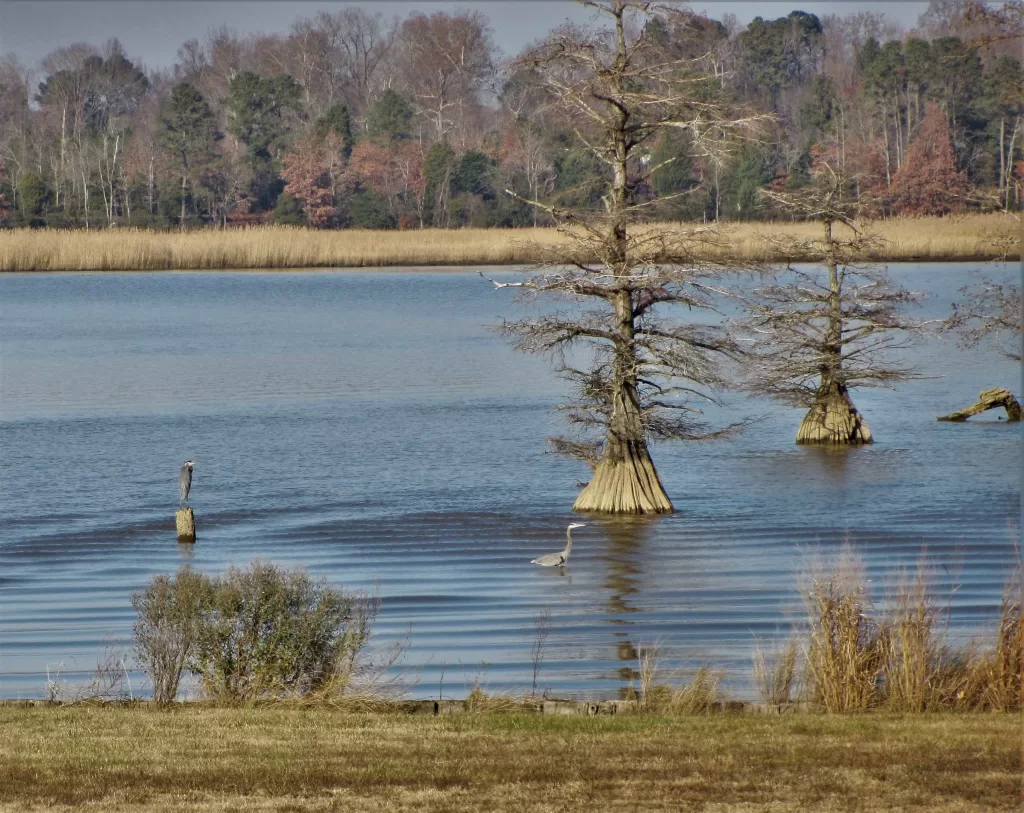
Great Blue Herons live among the bald Cypress trees, Taxodium distichum, growing in Sandy Bay near Jamestown Island.
Most North American indigenous nations recognize the ancient spirits of the land and honor them through their spiritual practices. They cooperate with these elemental beings to ask for good crops, rain, healing, and other assistance necessary for their people. These ancient intelligences didn’t move on simply because immigrants moved in and displaced the native people. The spiritual forces of the land remain active even today.
Various writers over the past 400 years wrote about their own encounters with elemental beings which they interpreted as fairies, elves, gnomes, or other creatures. These beings turn up frequently in popular literature.
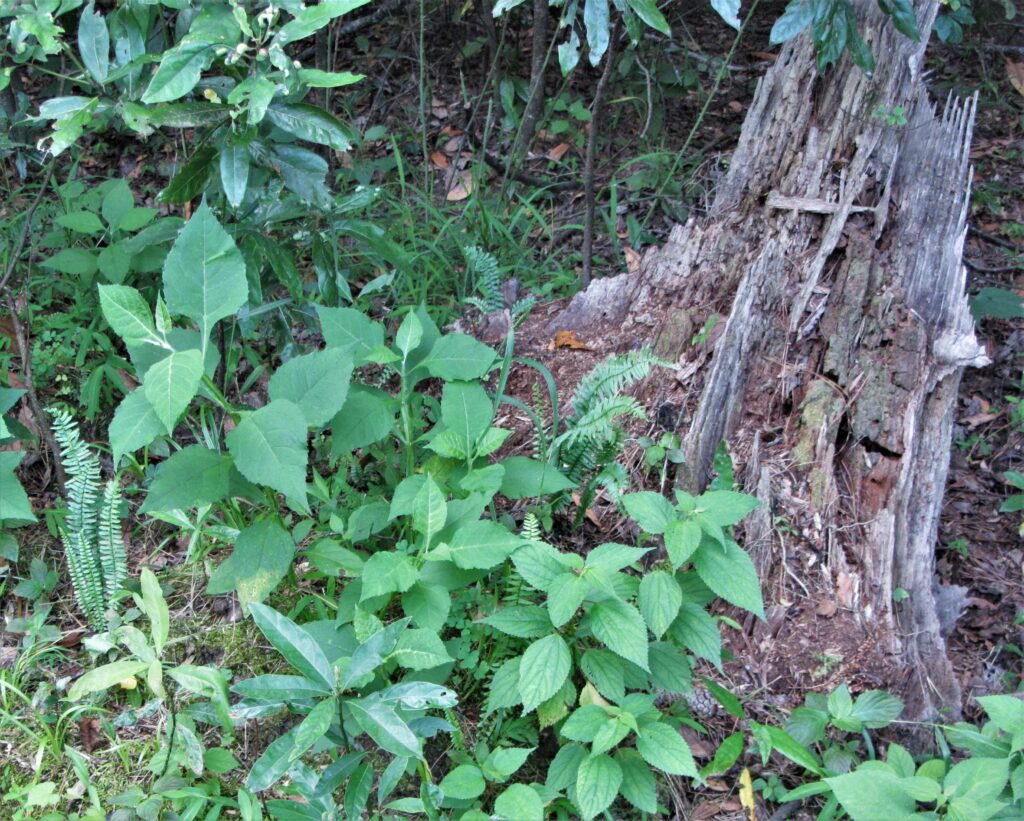
Ebony spleenwort ferns, Asplenium platyneuron, grow around a decaying stump among other native plants.
The Caddy family, including their friend Dorothy Maclean, moved into a trailer in a caravan park at Findhorn, on the shores of the Moray Firth in northern Scotland in 1962, after they lost their positions at a local hotel. When they couldn’t immediately find other work, they decided to begin planting a kitchen garden to supplement their meals.
The adults of the family had a practice of asking for guidance from ‘the God within’ each day, and so asked for guidance about how to raise food on the sandy, poor soil in the caravan park where they were living. This was the humble beginning of what later became the Findhorn Foundation, an experimental community that made intentional contact with elemental beings.
Their guidance directed them to ask for assistance from the devas, angelic beings responsible for ensuring that each type of plant grows true to its intended pattern or archetype. They later learned that the elemental fairies tended to each plant to help it grow. By asking questions of the devas, and working with the local fairies, they learned how to improve the soil, site and cultivate each type of plant, and how to make their garden thrive.
The results were astounding, yielding unusually large and high-quality vegetables, herbs, and flowers raised on soil that was simply sand when they began their garden. These original gardeners, Peter and Eileen Caddy and Dorothy Maclean, entered an intentional partnership with the devas and fairies, asking for guidance and assistance each day.
While Dorothy could communicate with the devas, neither Eileen nor Peter received their messages. Nor could they see or hear the fairies working in their garden. They relied on their friend, Robert Ogilvie Crombie, known as ROC, who had already established his connections to the elemental kingdom near his home in Edinburgh, Scotland. He assisted in communicating with the fairies tending to their garden.
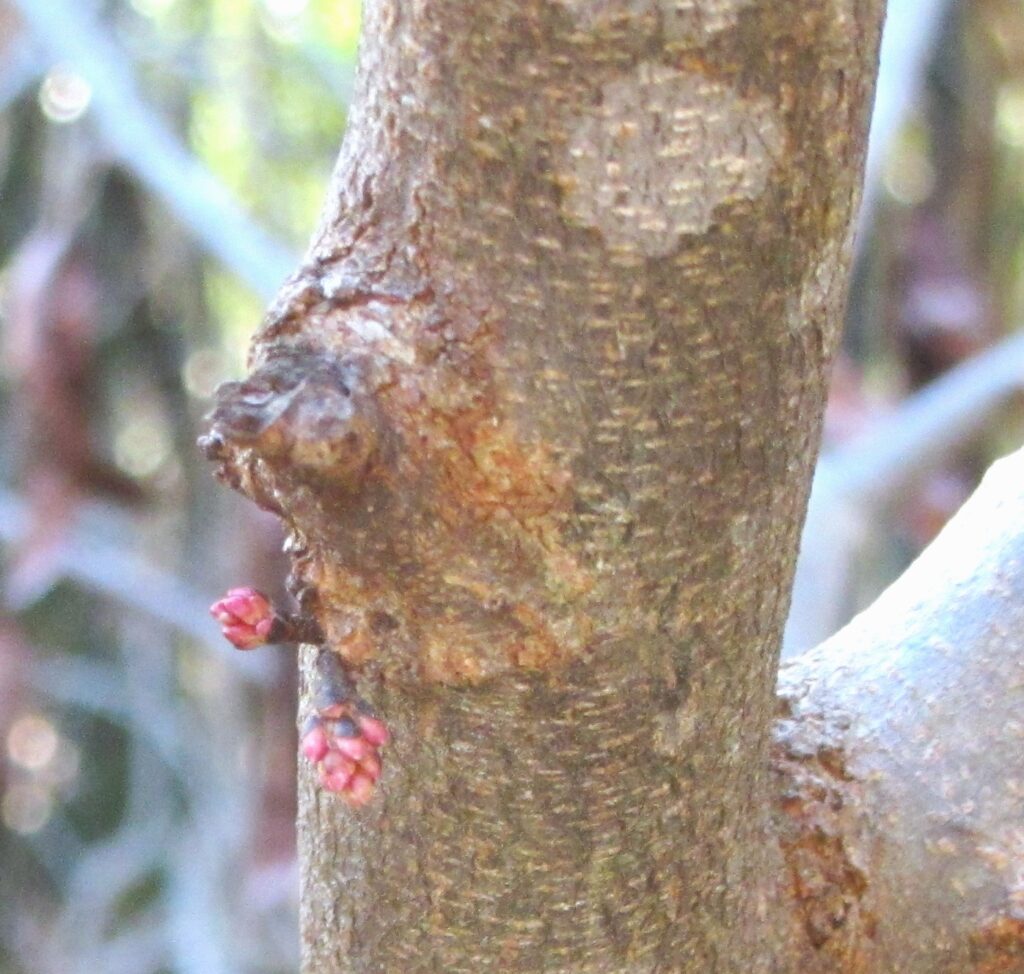
Native redbud, Cercis canadensis
If this sounds like a story too strange to believe, know that it is well-documented through photographs, firsthand accounts, contemporary news coverage, and now a series of books relating the story of the Findhorn community. As the flowers and vegetables grew, more people came at first to visit, and then to join this effort at cooperation between humans, elementals and plants. No one else in the area, or even in the United Kingdom, was able to grow vegetables and fruits of comparable size, vitality or quality. We are wise to maintain our sense of ‘epistemological humility’ and keep an open mind about how these unusual results came about in a garden grown on a cold, windy beach.
The energetic beings of the elemental kingdom may at times seem hostile to humans, and at other times ambivalent. But ROC’s interactions with a wide variety of these beings, including the ancient being known in Greek culture as Pan, demonstrated that they understand that it is important to work cooperatively with mankind for the good of planet Earth.
We share the planet with so many other life forms. All are part of one creation and originate from the divine creator of all. And yet we humans are the ones with the power to disrupt its natural systems and destroy its ecosystem, which has grave consequences for the elementals as well as for all plant and animal life, including humans.

White mulberry, Morus alba
Elemental beings who interacted with the community at Findhorn used this opportunity to communicate and cooperate to re-establish a relationship with mankind. They also asked members of the Findhorn community to share their message more widely so that more and more people would wake up to their reality. Like Tinkerbell, they want humans to first believe in their existence, and then to enter into a cooperative relationship with them to heal our planet Earth.
So, a true ‘fairy garden,’ is one where fairies and all other helpful elementals are welcome. Don’t we all want to be acknowledged, and appreciated for the contributions we make? Even if we can’t see fairies ourselves, we perhaps sense their presence as guardians of our trees and co-creators in our gardens. The elemental beings want us to acknowledge them and work with them.
What does that mean? If we accept the reality of elemental beings, then we also understand that some are likely already at work in our garden spaces. Folklore provides a lot of information about how fairies inhabit trees, particularly mature trees, ferns, and various flowering plants. Once we open our awareness to the possibility of these elementals, then we acknowledge them, express appreciation for their help, and adopt gardening practices that are harmonious with that spirit of cooperation.
The following are a few guidelines given to Dorothy and ROC while they were at Findhorn. We can implement these practices to consciously cooperate with elemental nature intelligences:
Maintain some small wild area on your property as a place set aside for the fairies. Choose an out of the way area you don’t tend and rarely visit.
Stop using pesticides like insecticides or herbicides and avoid strong fertilizers. Expect the elementals and the natural web of life to resolve ‘pest’ problems. Recycle garden trimmings and other organic materials from the kitchen into compost to feed the soil.
Nurture life continually, so something is always growing in the garden. Include evergreen ferns and other shrubs and perennials that grow in winter. Use succession planting to maintain some type of vegetable, herb, or flowering crop year-round.
Refrain from cutting or pruning branches in flower or active growth. Intervene with the natural growth pattern of each plant as little as possible. If it is necessary to cut a plant or transplant something while it is actively growing, have a clear purpose in mind for your actions and treat the plant gently.
Respect the many creatures living in the soil and disturb it as little as possible. Limit tilling and digging and tend the garden in the least invasive way. Remain mindful of those elemental beings that live in the soil, working with the network of mycelium which connects plants to one another.
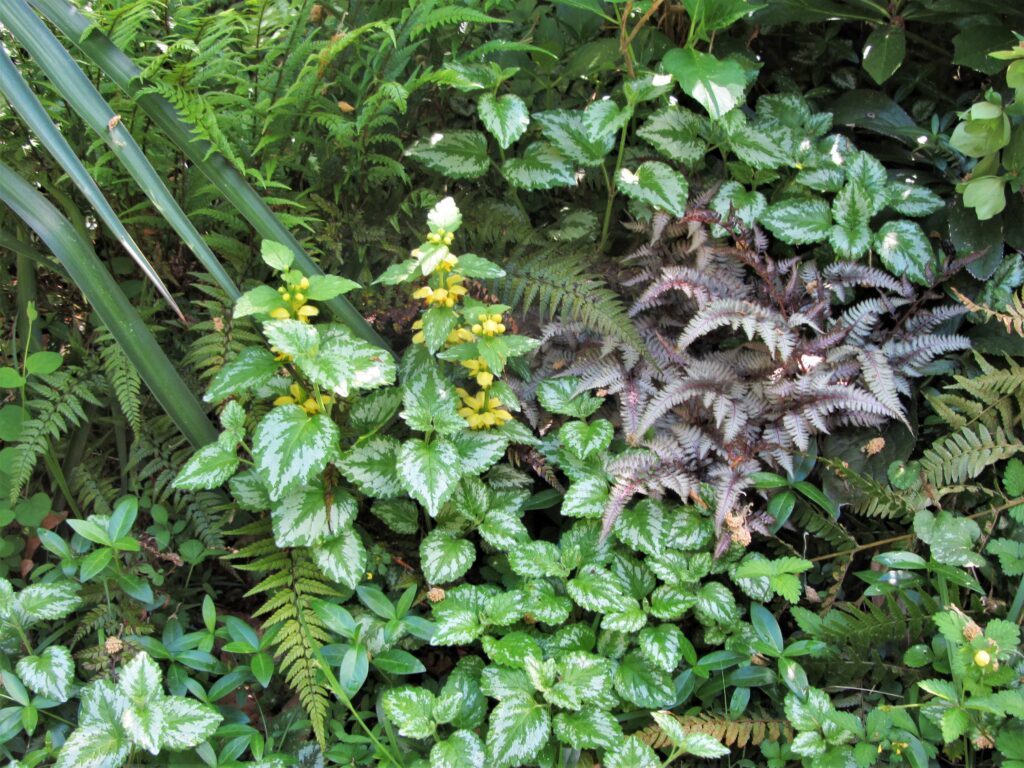
Lamium maculatum blooms beside assorted ferns and Vinca.
Choose plants with the reputation for attracting fairies. A partial list is given at the end of this article. Plant trees as well as ferns in the garden, as trees are very important to the elementals and the work they do. Mature trees are especially important for the proper functioning of our environment.
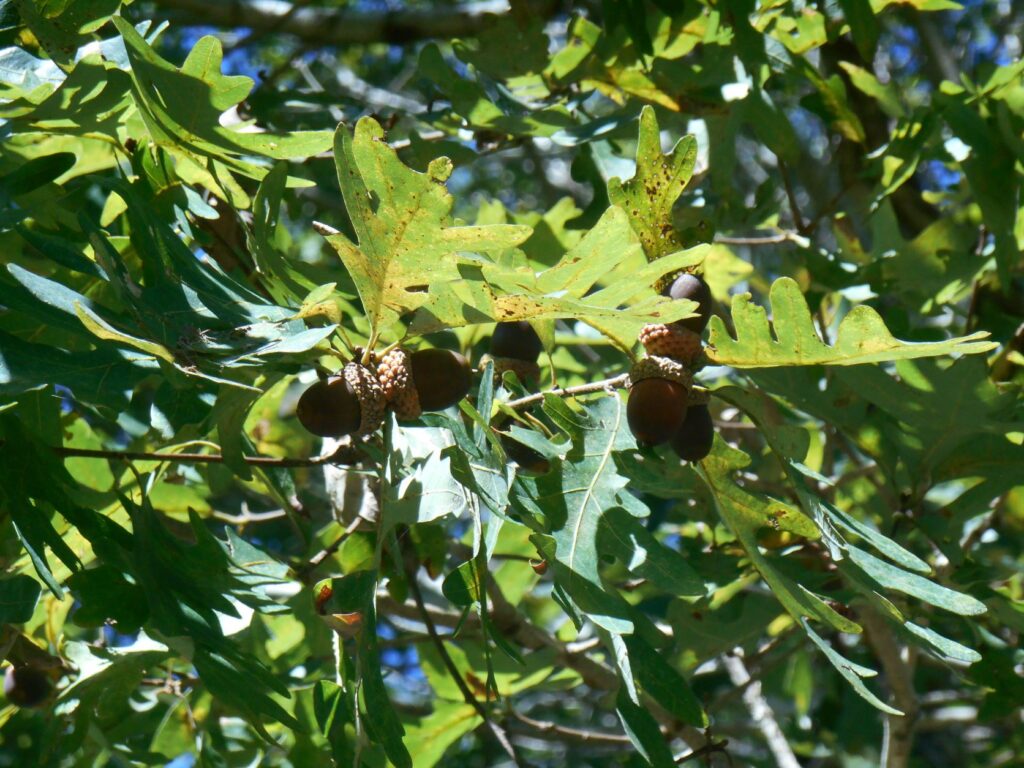
White oak, Quercus alba
Provide a constant source of water in the garden whether in a pond, a water feature, or simply a bowl of water. Moving water, like in a fountain or stream, is best.

Cherrybark oak, Q. pagoda, can grow in sand and silt and withstand occasional flooding from brackish waterways.
Take time to sit quietly in the garden and observe. Spend quiet time walking around and remain open to inspiration for fixing any problems you notice and for making your space even more beautiful and productive.
Include other things believed to attract fairies like gazing balls, wind chimes, rocks and crystals, mirrors, and even ‘fairy houses’ made from natural, found materials like sticks, cones, bark, moss, stones, and twine.
Fairy lore tells us that most elemental beings remain wary of humans, largely because our behavior mystifies them. They realize that many humans aren’t attuned to the natural world and don’t appreciate the interconnectedness of life. In the folklore, fairies operate through something like a barter system of favors and gifts. If you do them a favor, or offer a gift, then they are obliged to assist you. If they assist you, then they expect something in return. Leaving a small gift of food or an item they find pleasing is a proven way to build a relationship of mutual assistance.
Cultivating a fairy garden is not without risks. Angry fairies are notorious for the tricks they play on humans. So once started, keep your fairies happy. They may appear to you as a dragonfly or hummingbird, a flash of light, a sweet fragrance in the breeze, or a sudden insight into how to tend some part of your garden.
A true fairy garden will be filled with life, lush growth, and a sense of peace and contentment. Isn’t that what we all hope to create as we tend our bit of the Earth anyway?
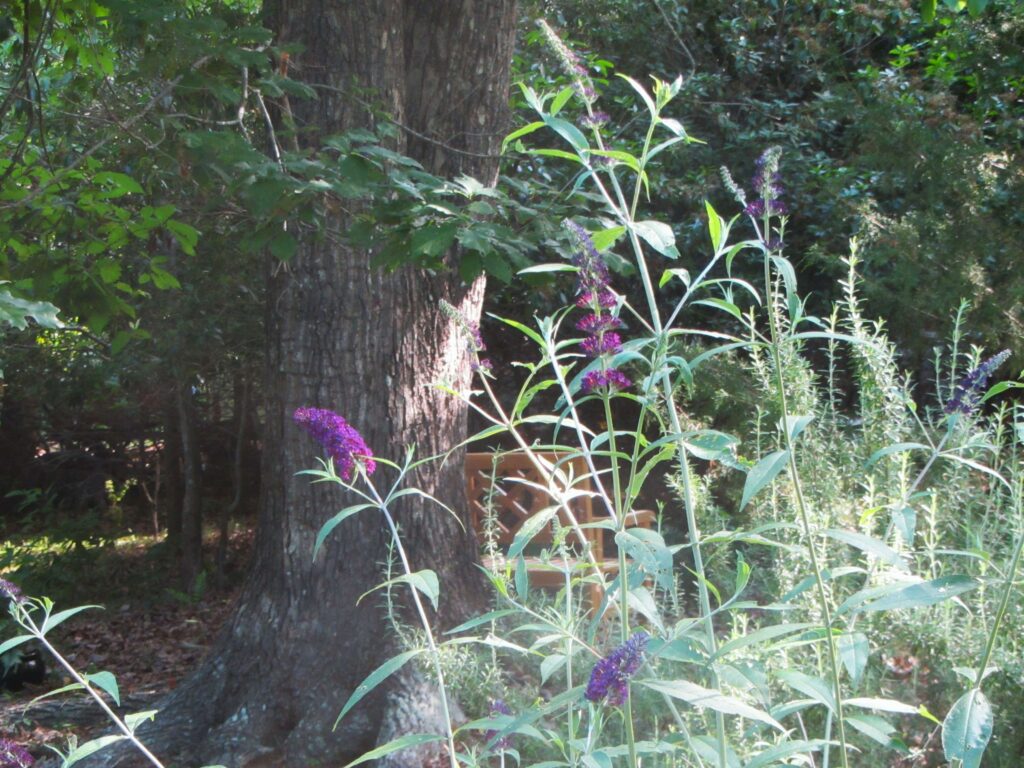
Butterfly bush, Buddleia davidii, blooms under a swamp chestnut oak, Q. michauxii.
Plants and fungi to include in your fairy fern garden:
Trees and Shrubs
Plant native oak, apple, rose, mountain ash or rowan, birch, elder, blackberry, hazel, hawthorn, and holly. Fairies prefer trees that produce flowers and fruits or nuts.
Ferns and Mosses
Fairies are believed to especially love ferns and mosses, particularly as a place to rest. Include lush patches of any type of fern to attract elementals to your garden. Evergreen ferns are especially appreciated as they provide shelter through the winter.
Herbs
Include traditional herbs like rosemary, thyme, fennel, lavender, Salvia ssp., and germander.
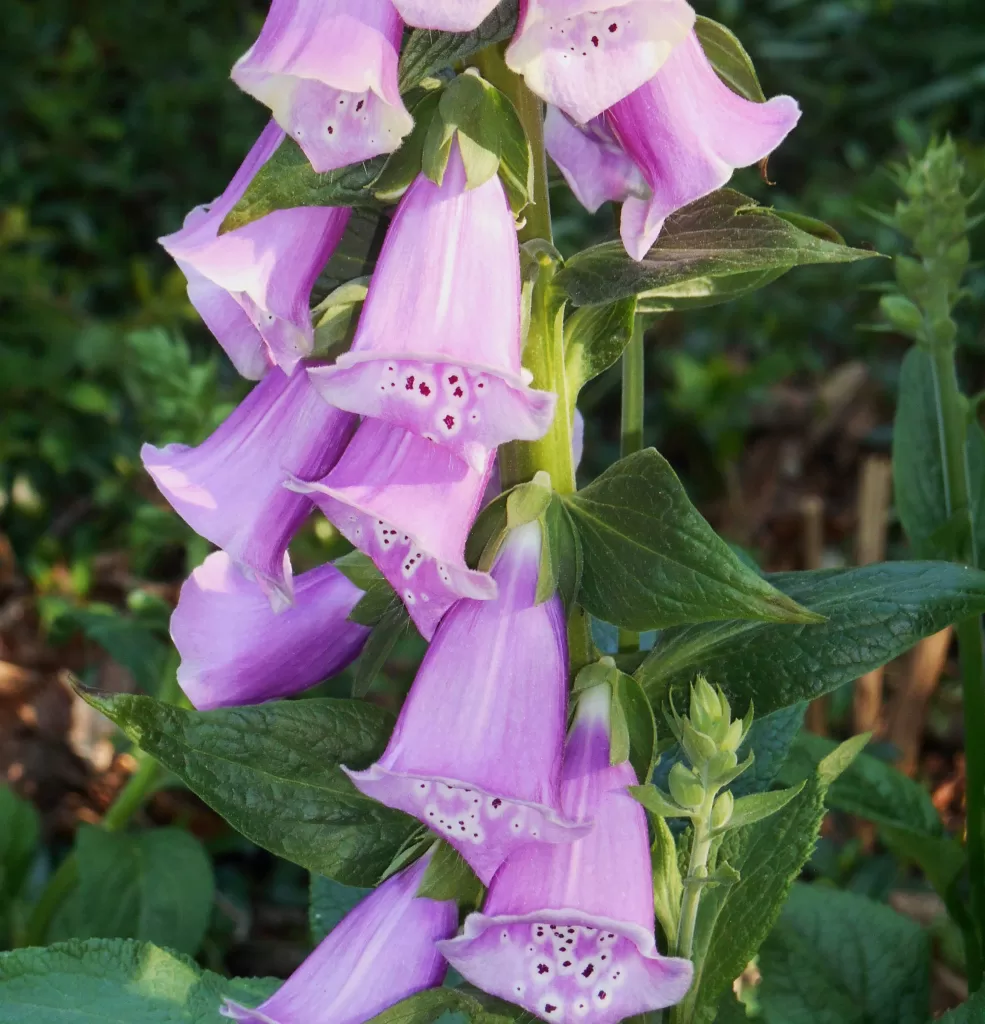
Foxglove, Digitalis purpurea
Flowers
Include wildflowers and perennials such as foxglove, columbine, forget me nots, Lenten roses, Impatiens, Iris, peony, periwinkle, snapdragon, bluebells, cowslips, clover.
Fungi
Nurture all types of lichens, mushrooms, and their underground network of mycelium, which connect one plant to another in the soil. Add products containing appropriate fungal spores when planting new trees and perennials. A ring of mushrooms growing in grassy, moss, or mulch is sometimes called a ‘fairy ring’ and is considered a sign of good luck.
All photos by E. L. McCoy
Further Resources:
Crombie, R. Ogilvie. Encounters with Nature Spirits: Co-creating with the Elemental Kingdom. Findhorn Press. 2018.
Hawken, Paul. The Magic of Findhorn. Bantam Books 1976.
Kirk, Robert and Andrew Lang. The Secret Commonwealth of Elves, Fauns, and Fairies. Digireads.com Publishing. 2020.
Lenihan, Eddie and Carolyn Eve Green. Meeting the Other Crowd: The Fairy Stories of Hidden Ireland. Tarcherperigee. 2004.
Maclean, Dorothy. Call of the Trees. Lorian Press. 2011.
Maclean, Dorothy. To Hear the Angels Sing: An Odyssey of Co-Creation with the Devic Kingdoms. Lorian Press. 2011.
Matthews, John. The Sidhe: Wisdom from the Celtic Otherworld. Lorian Press. 2011.
The Findhorn Community. The Findhorn Garden Story: Inspired Color Photos Reveal the Magic. Findhorn Press. 2008.
Tomkins, Peter and Christopher Bird. The Secret Life of Plants: A Fascinating Account of the Physical, Emotional, and Spiritual Relations Between Plants and Man. Harper Paperbacks. 2018.
Wright, Machaelle Small. Perelandra Garden Workbook: A Complete Guide to Gardening With Nature Intelligences. Perelandra, Ltd. 1987.
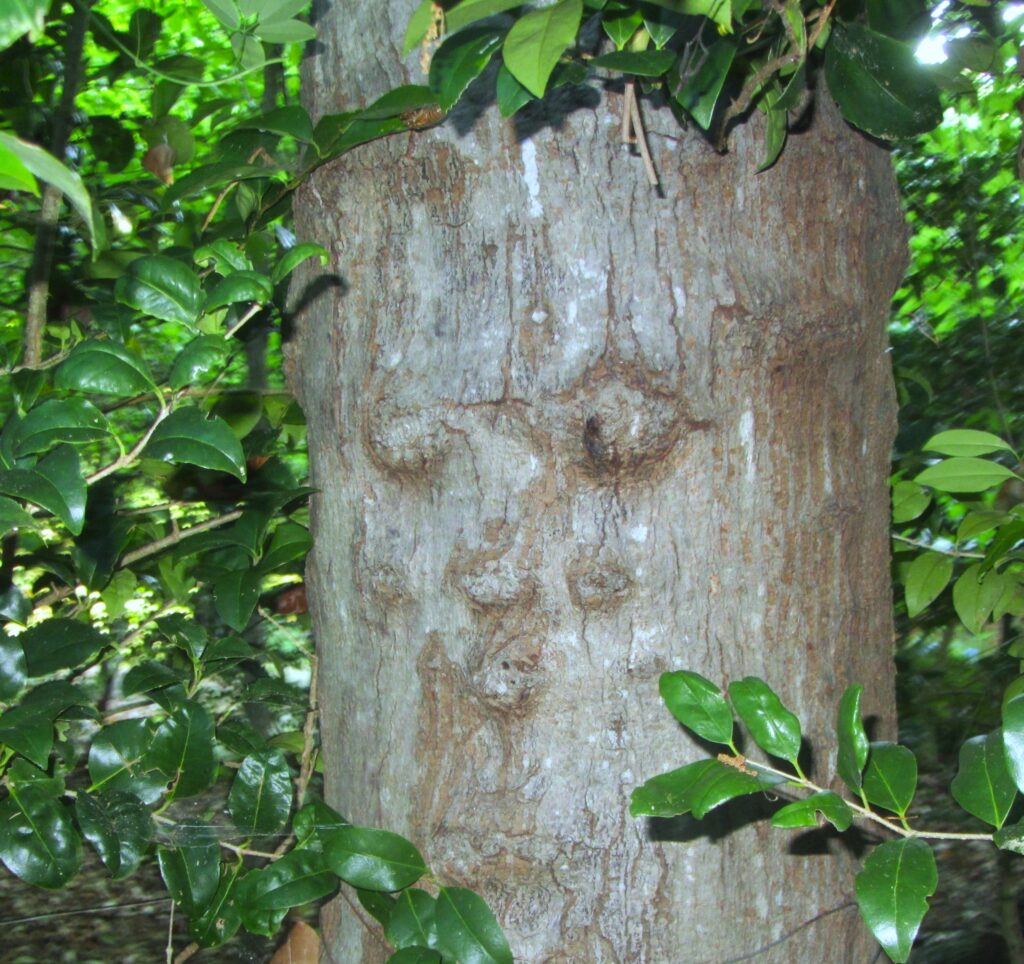
Red maple, Acer rubrum












